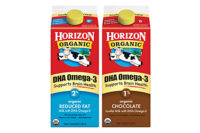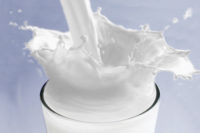The catch of the day: omega-3s

Over the past year, much has transpired on the fatty acid front, including updated dietary recommendations and final rulings for nutrition labeling. Both events will have major implications for formulations, packaging, and promotion of foods and beverages fortified with omega-3s.
Omega-3s are essential polyunsaturated fats crucial for visual and neurological development and beneficial for heart and brain health. The two forms of omega-3s responsible for the bulk of these benefits are DHA and EPA, both primarily found in fatty fish/fish oil. Other forms of omega-3s include ALA (from certain plant foods), and SDA (not typically found in food; however, SDA-rich oil is extracted from genetically modified soybeans). ALA and SDA are converted by the body to EPA and DHA, but in amounts considered insignificant.
Dietary recommendations
In January 2014, the Academy of Nutrition and Dietetics released an updated position paper on dietary fatty acids and healthy adults. Their stance: Healthy adults should consume 20% to 35% of calories from fat, increase consumption of omega-3 fats and limit intake of saturated and trans fats via a food-based approach including regular consumption of fatty fish (≥ 2 servings/week), nuts and seeds, lean meats and poultry, low-fat dairy products, vegetables, fruits, whole grains and legumes.
The major change from the Academy’s previous position paper is an emphasis on omega-3s.
“There is strong evidence that all Americans need to increase intake [of omega-3s] and there would be measurable health benefits for the population,” said Gretchen Vannice, registered dietitian and lead author of the updated position paper.
The second focus is to reduce saturated fat intake and replace those calories with polyunsaturated fats instead of refined carbohydrates while keeping calories within healthy levels.
Omega-3 recommendations for specific populations have also been updated. In June 2014, the Food and Drug Administration and the Environmental Protection Agency issued draft revised recommendations stating that women who may become pregnant, women who are pregnant and breastfeeding, and young children should eat more fish (including shellfish): 8 to 12 ounces of fish lower in mercury per week (the 2004 recommendation was to eat up to 12 ounces per week, with no minimum). As rationale, the agencies cite the latest science strongly indicating that 8 to 12 ounces per week of a variety of fish lower in mercury during pregnancy benefits fetal growth and development and, in addition, may reduce adults’ risk of cardiac death.
Under the Federal Food, Drug & Cosmetic Act, nutrient content claims are considered only for nutrients with a reference level. The 2005 Dietary Reference Intakes (DRI) recommends that 0.6% to 1.2% of energy comes from omega-3s but did not set a Recommended Dietary Allowance or Estimated Average Requirement for any of the omega-3 forms.
The report did, however, provide an Adequate Intake for ALA: 1.1 to 1.6 grams/day. Based on this information, the FDA recently prohibited nutrient content claims for DHA and EPA but allowed specific nutrient content claims for ALA (see table). This FDA ruling finalizes the 2007 proposed ruling and will take effect Jan. 1, 2016. According to Vannice, in 2015, the DRI committee will consider setting a DRI for EPA and DHA.
Currently, one qualified health claim is available for conventional foods containing EPA and DHA and reduced risk of coronary heart disease. “In the future, there may be a qualified health claim that healthy levels of EPA and DHA help normalize blood pressure,” Vannice said.
Fortifying with omega-3s
Eating fish/seafood is the best way to get DHA and EPA (recommendations range from 450 to 1,000 milligrams DHA+EPA/day). For those who can’t or won’t eat it, fortified foods and supplements are the next best. When fortifying dairy products with omega-3s, Vannice advises adding EPA and DHA that’s purified from marine sources or the vegetarian/algal form of DHA, rather than adding ALA or SDA.
There is a smoothie/pudding product fortified with fish oil on the market and cookies and chocolates fortified with algal DHA available by mail order that taste great, said Vannice. Plus, a few brands of fluid milk and yogurt with DHA are on the market. There appears to be an ocean of opportunity for product innovation
Looking for a reprint of this article?
From high-res PDFs to custom plaques, order your copy today!









